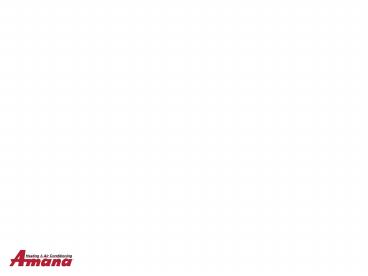EXPANSION VALVE SYSTEM - PowerPoint PPT Presentation
Title:
EXPANSION VALVE SYSTEM
Description:
expansion valve system using superheat calculator get the return wet bulb temperature at the return air grill using a sling psychrometer or meter capable of reading ... – PowerPoint PPT presentation
Number of Views:72
Avg rating:3.0/5.0
Title: EXPANSION VALVE SYSTEM
1
(No Transcript)
2
EXPANSION VALVE SYSTEM
1. Purge gauge lines. Connect service gauge
manifold to base-valve service ports. Run system
at least 10 minutes to allow pressure to
stabilize. 2. Temporarily install thermometer on
liquid (small) line near liquid line service
valve with adequate contact and insulate for best
possible reading. 3. Check subcooling and
superheat. Systems with TXV application should
have a subcooling and superheat of 9 3 ºF. a. If
subcooling and superheat are low, adjust TXV to 9
3ºF then check subcooling. b. If subcooling is
low and superheat is high, add charge to raise
subcooling to 9 3ºF then check superheat. c. If
subcooling and superheat are high, adjust TXV
valve to 9 3ºF then check subcooling. d. If
subcooling is high and superheat is low, adjust
TXV valve to 9 3ºF superheat and remove
chargeto lower the subcooling to 9 3ºF. NOTE
Do NOT adjust the charge based on suction
pressure unless there is a gross undercharge. 4.
Disconnect manifold set, installation is
complete. Subcooling Formula Sat. Liquid Temp.
- Liquid Line Temp.
3
SUPERHEAT METHOD
THE SUPERHEAT METHOD IS USED FOR SYSTEMS USING A
FIXED ORIFICE TYPE METERING DEVICE
Orifice Metering Device
4
USING SUPERHEAT CALCULATOR
- GET THE RETURN WET BULB TEMPERATURE AT THE RETURN
AIR GRILL USING A SLING PSYCHROMETER OR METER
CAPABLE OF READING WET BULB TEMPERTURE - GET THE OUTSIDE AMBIENT TEMPERATURE IN THE SHADE
OF THE CONDENSING UNIT - SET ARROW TO INDOOR ENTERING AIR WET BULB
TEMPERATURE - LOCATE CONDENSER ENTERING AIR DRY BULB
TEMPERATURE - READ REQUIRED SUPERHEAT TEMPERATURE AT CONDENSER
ENTERING AIR DRY BULB TEMPERATURE - ADD CHARGE TO LOWER SUPER HEAT
- REMOVE CHARGE TO RAISE SUPERHEAT
5
USING SUPERHEAT TABLE
- GET THE OUTSIDE AMBIENT TEMPERATURE IN THE SHADE
OF THE CONDENSING UNIT - GET THE RETURN DRY BULB TEMPERATURE AT THE RETURN
AIR GRILL - INTERSECT THE 2 NUMBERS
- THAT WILL GIVE YOU THE AMOUNT OF SUPERHEAT YOU
NEED
6
Super-heat and Sub-cooling charts
- The super-heat and sub-cooling charts will be
posted on the back side of the control door.
7
EXAMPLE
- AMBIENT OUTSIDE TEMPERATURE (IN THE SHADE OF THE
CONDENSOR) IS 95 DEGRESS - RETURN AIR (DRY BULB) IS 75 DEGREES
- INTERSECT THE 2 NUMBERS AND YOUR SUPER HEAT WILL
BE 5 DEGREE
8
INSTALL THERMOMETER
- INSTALL ON THE SUCTION LINE ( LARGER LINE
) - INSULATE THE PROBE FOR AN MORE ACCURATE READING
9
READING THE SATURATED EVAPORATER TEMPERTURE
- ON THE LOW SIDE OF YOUR COMPOUND GAUGES ( BLUE )
- THE OUTSIDE READING IS YOUR PRESSURE
- THE INSIDE (R 22) IS YOUR SATURATED EVAPORIZING
TEMPERTURE
10
EXAMPLE
- YOUR LOW SIDE PRESSURE IS 75 PSI
- DIRECTLY BELOW THAT NUMBER IS THE SATURATED
EVAPORIZING TEMPERATURE, WHICH IS 44 DEGREES - TAKE YOU SUCTION LINE TEMPERTURE, WHICH IS 65
DEGREE
11
EXAMPLE
- SUBTRACT THE 2 NUMBERS AND THAT HOW MUCH
SUPEREHEAT YOU HAVE - 65 - 44 21 SUPERHEAT
- WE ONLY NEEDED 5 DEGREES
- ADD CHARGE TO LOWER SUPER HEAT
- REMOVE CHARGE TO RAISE SUPERHEAT
12
Charging Two Stage Units
- Set unit to operate at low stage cooling.
- Operate for 10 minutes.
- Check and record low stage liquid pressure at the
service valve. - Set thermostat to operate at high stage.
- Operate for 10 minutes.
- Check and record high stage liquid pressure at
service valve.
13
Charging Two Stage Units
- The high stage pressure should be noticeably
higher than the low stage liquid pressure. - If the pressures are identical, the compressor
did not switch from low to high stage. - Verify wiring and t-stat settings.
- Run the unit on low stage and make the final
charge adjustments on low stage. - Do not adjust charge to change sub-cooling on
high stage. Charge adjustments must only be made
under low stage cooling.
14
(No Transcript)
15
(No Transcript)































